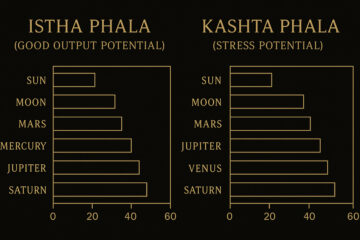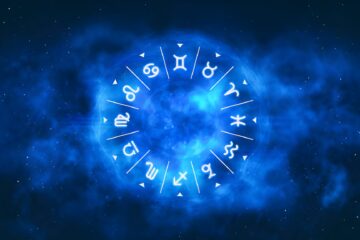Divisional charts in Vedic astrology, also called Vargas, are not “bonus” charts for advanced astrologers only. They are essential tools that refine what the birth chart (D1) is already saying. D1 shows the overall storyline of a life. The divisional charts tell you how that storyline gets expressed in specific areas like marriage (D9), career (D10), siblings and initiative (D3), parents and lineage (D12), or spiritual maturity (D20). But here is the rule that protects you from misreading: a divisional chart never overrides D1. It only clarifies how one area of life will live out the karma already promised in D1.
If you’re serious about learning how to read divisional charts in Vedic astrology, you have to train yourself to think like this: The Rasi chart is the trunk; each Varga is a branch. A branch cannot survive without the trunk’s sap. In this guide we’ll talk about when divisionals matter, what Navamsa is actually doing, why people argue about D10, how Vargottama works, and how to avoid classic beginner mistakes like treating a yoga in a divisional as if it guarantees physical events by itself.
How to Read Divisional Charts in Vedic Astrology Without Getting Lost
Every divisional chart isolates a specific domain of life. D1 is the full organism. D9 (Navamsa) is marriage, dharma, and inner maturity. D10 (Dasamsa) is career and public karma. D7 connects to children and reproduction of one’s legacy. D12 reflects parents, lineage, inheritance of patterns. D20 goes into spiritual practice. You do not read these as separate horoscopes. You read them as specialized layers of the main promise in D1.
So if the 7th house and Venus are very weak in D1, you should not expect a perfect marriage just because the D9 looks pretty. But if D1 shows mixed relationship karma, then a strong D9 can tell you, “Yes, the path may be rocky, but growth, grace, and companionship mature over time.” This is how we keep it grounded and compassionate instead of fatalistic.
Also remember timing. Dashas propose, transits dispose. A divisional chart shows where in life a planet will express itself. The Mahadasha/Antardasha tells you when that planet’s storyline becomes loud. Slow transits (Saturn, Jupiter, Rahu/Ketu) decide how visible it becomes in the physical world.
Navamsa (D9) and Later Maturity
Students always ask: “Do planets in the Navamsa take effect only after age 30?” The honest answer is more nuanced. The Navamsa chart, or D9, represents the refined maturity of planets — how they ripen through lived experience. If D1 shows the seed and trunk, D9 is the fruit. It’s where you see whether the planet’s energy becomes wise, integrated, devotional, and aligned with dharma.
Because marriage is often one of the biggest catalysts for spiritual and psychological maturity, D9 is strongly linked to spouse and partnership. But Navamsa also tells you how a planet ages inside you. A planet that’s unstable in D1 but strong in D9 may create early struggle but eventual grace. A planet that is strong in D1 but falls apart in D9 can give early wins that later feel hollow, or that require spiritual correction.
Here’s a subtle point about dignity in the Navamsa: in any divisional chart, a planet in its own sign or Mooltrikona tends to outperform a planet that is merely “exalted” in that divisional. You’ll see this echoed across classical tradition. A Jupiter in Sagittarius or Pisces, across multiple Vargas, often gives cleaner, more aligned results than “exalted” Jupiter in Cancer in a single divisional. Own sign = self-directed. Mooltrikona = mission-oriented. That’s sustainable power.
Also: exaltation and debilitation are physically meaningful in the Rasi chart, where nakshatra padas and exact degrees exist in the sky. In higher divisional charts, those degree-based exaltation points become symbolic harmonics, not physical placements. So do not panic if your Moon looks “debilitated” in D9. If Moon is exalted in Taurus in D1, that baseline nourishment does not vanish because D9 shows a weaker sign. D1 still rules the physical reality.
Rasi vs Navamsa: How They Talk to Each Other
If you’re comparing the Rasi chart and the Navamsa, there’s a classical technique called Rashi Tulya Navamsa. In simple terms, you map Navamsa positions back onto the Rasi chart, sign by sign, to see which Rasi houses get activated by the dignity shown in D9. For example, if Jupiter sits in Cancer in D9 and Jupiter sits in the 9th house in D1, then you also consider how Cancer (the sign you saw in D9) relates to the D1 framework, including its 7th-house implications for partnership. This is how D9 “speaks back” to marriage, dharma, guidance, and long-term belief structure in the main chart.
This technique is not fortune-telling. It is refinement. It helps you see where growth is likely to express in real life, and which houses in D1 become gateways for that growth. This is how you responsibly read divisional charts in Vedic astrology: never isolated, always relational.
Is Saturn Better in Aquarius, Capricorn, or Libra in Navamsa?
When people start comparing dignity in D9, the Saturn question always shows up. Saturn is considered most at home in Aquarius, then Capricorn, then Libra, because Aquarius most purely reflects Saturn’s long-game intelligence, social duty, structure, and accountability. Capricorn is also Saturn’s own sign and gives control, discipline, strategic ambition. Libra can be workable for Saturn, but it is not automatically “no problems forever.”
One more nuance: Vargottama. A planet is called Vargottama when it repeats the same sign in D1 and in a divisional chart such as D9. Repetition is amplification. If Saturn is in Aquarius in both D1 and D9, Saturn becomes extremely stable in its nature. It knows who it is and how it wants to operate. That’s usually excellent. But if a planet becomes Vargottama in a sign where it’s normally uncomfortable — for Saturn that would be Aries, for example — then you’re amplifying stress, not easing it. Vargottama means intensified, not automatically blessed.
From a practical standpoint, many teachers will tell you that the Saptavarga (seven key Vargas) contribute a major share — roughly 60–65% — of a planet’s measured strength in systems like Shadbala. The logic is simple: repeated dignity across core Vargas means the planet keeps showing up in a reliable way throughout many parts of life. This is why astrologers care so much about whether Saturn is steady in Capricorn/Aquarius across D1, D9, and D10. You’re looking for structural reliability over time, not just a single “lucky placement.”
Should You Read Yogas Inside Divisional Charts?
This is one of the most misunderstood topics for students. You might see Gajakesari Yoga (Moon-Jupiter relationship) appearing in a divisional and assume, “Wow, guaranteed blessings!” Careful. Yogas in divisional charts are not to be read as literal event promises the way they are in D1.
The reason is technical. Vargas are mathematical partitions of signs, not full physical skies. The angular relationships you see in a divisional are symbolic of how that life domain refines the D1 promise. They are not standalone “you will be rich forever” guarantees.
So how do we use them? We look for repetition. If Moon and Jupiter form a supportive yoga in D1 and they repeat a strong connection in D9, then yes — that greatly strengthens their influence on marriage, spiritual stabilization, wisdom, and emotional nourishment. If Mars and Mercury form a harsh combination in both D1 and D10, that pattern can show up loudly in career behavior: conflict in communications, pressure in performance, arguments with authority. Repetition across D1 and a relevant Varga is karmic confirmation.
In short, divisional yogas matter most when they echo the main chart. They deepen the story instead of writing a new one. This approach keeps you honest, and it keeps you from promising destiny to someone based solely on a pretty D9 or D10.
D10 (Dasamsa) and Career Expression
The D10 chart (Dasamsa) is where we study public karma, impact, authority, visibility, professional burdens, and how a person takes their place in the world. You should never read D10 without checking the 10th house, 10th lord, and functional benefic vs functional malefic dynamics in D1. But once D1 shows “yes, career matters,” D10 tells you how that career actually feels and evolves.
Here is a practical rule for D10: dignity matters more than catchy labels like “exalted vs debilitated” in isolation. Saturn in Aquarius or Capricorn in D10 is usually excellent for long-term career consolidation, because Saturn is operating from its own blueprint. Saturn in Libra can negotiate structures and alliances. While, Saturn in Aries can feel reactive, urgent, pressured, or misunderstood, and the native often learns boundaries through conflict with authority. You’re not just asking “Is it exalted?” You’re asking “Is this planet acting like itself in this arena?”
When a planet is Vargottama in D10 (same sign in D1 and D10), that planet becomes decisive for career. During its Mahadasha, professional shifts, recognition, responsibility, or crisis around role and identity tend to become non-negotiable. Again, this is not inherently “good” or “bad.” It’s just loud and undeniable.
Important Notes
If two planets are conjunct in both D1 and D9, what does that mean?
When two planets sit together in both the Rasi chart and the Navamsa, it signals a deep karmic link between them. Mathematically, for that to happen they’re usually within a few degrees of each other in D1. Energetically, it says, “These two are working together across lifetimes.” The flavor depends on what those planets rule. If they’re benefics, this can feel like enduring support in marriage or dharma. If they’re malefics, it can feel like intense lessons through partnership, intimacy, or spiritual pressure. Repetition across D1 and D9 is not casual — it’s a signature you take seriously.
Is a ‘debilitated Saturn in D10’ secretly good?
There’s a trend online that says “debilitated Saturn in D10 = amazing for career.” Be careful. Exaltation/debilitation in divisional charts is not the main metric. The real question is: Is Saturn in its own or a friendly sign? Is it functionally benefic or functional malefic for the Lagna in D1? Is it repeating dignity across D1, D9, and D10? Saturn in Aquarius or Capricorn tends to stabilize career. Saturn in Aries or Cancer in D10 tends to create friction, burnout, or harsh lessons unless other supports exist. There is no universal “debilitation is secretly good” rule.
Are Yogas inside divisional charts valid?
They are symbolically valid, but not physically predictive by themselves. If Moon and Jupiter form a supportive yoga in D1 and you also see them aligned in D9, that massively reinforces emotional security, faith, and spiritual growth within marriage. But if you only see it in the divisional and not in D1, you do not promise “lifetime blessings.” You flag it as a subtle theme that might emerge under the right Mahadasha and transit timing.
Is the D60 (Shastiamsa) chart really more important than D1?
D60 is said to reflect deep karmic residue, but it’s extremely birth-time sensitive — it can change within a couple of minutes. Unless the birth time is verified down to the minute and the Ayanamsa (sidereal reference) is chosen carefully, reading D60 as absolute truth is risky. Experienced astrologers will glance at D60 for deeper insight, but reliable practical work usually focuses up to D10 first.
If a planet is debilitated in D1 but strong in a divisional, how do we read that?
The D1 chart still rules physical life, identity, and baseline experience. If a planet is debilitated in D1 but shows strength in D9, that often means: “This area of life is hard at first, but matures beautifully in partnership/dharma as you grow.” If it’s debilitated in D1 but strong in D10, that can mean career becomes the place where that planet heals itself. In other words, divisionals show refinement and redemption arcs, not instant escape from the D1 reality.
Do planets aspect or create Argala in divisional charts?
Classical full-aspect rules are anchored in the physical sky placements of the Rasi chart. Divisionals are mathematical reflections, so aspects there are more interpretive. Some advanced astrologers apply Argala (energetic intervention of one house on another) inside Vargas, but this is higher practice. For most students, keep aspects in D1 and use divisional charts to clarify context, not to reinvent physics.
What if a planet is Vargottama but weak in both charts?
Vargottama means amplified. If a planet is in the same sign in both D1 and D9 (or D10), that planet’s nature becomes louder and more defining. If that sign is hostile to the planet, you’re amplifying struggle. And, if the sign is friendly or own sign, you’re amplifying stability. A debilitated or inimical-sign Vargottama planet can feel like “the same wound keeps repeating until I grow through it.” In certain cases, Neechabhanga (cancellation of debilitation) or strong benefic support can transform that wound into a source of power over time.
FAQ
Do divisional charts in Vedic Astrology have their own Dashas?
No. Dashas come from the main chart, because that’s the chart of physical incarnation. Divisional charts show how that Dasha will express in a specific life area. For example, during Venus Mahadasha you’d study Venus in D1 for baseline promise, then Venus in D9 for marriage/dharma quality, then Venus in D10 for career/social expression. The timeline is from D1; the flavor is from the relevant Vargas.
Do Nakshatras work in divisional chart?
Nakshatras are based on actual sky sectors in the Rasi chart. Divisional charts are mathematical partitions of those signs. So “this planet is in this nakshatra pada in D9” is not physically literal. Use nakshatras for D1 timing work (like Vimshottari Dasha) and for mindset/psychological tone. Use Vargas to refine domain-specific expression.
What are Pushkara Navamsa and Pushkara Bhaga?
Pushkara Navamsa and Pushkara Bhaga are considered nourishing points that increase a planet’s ability to provide constructive, protective results. If a planet sits in one of these auspicious points, its significations tend to manifest more supportively during its Mahadasha, especially in relationships and spiritual alignment. You can treat Pushkara placements as “extra nutrition” for that planet’s storyline.
How do exchanges (Parivartana) in divisional charts work?
If two planets exchange signs within a divisional chart, we absolutely take note — especially for that life area. During the joint Dasha/Antardasha of those planets, the two themes can pull on each other. For example, in D10 that could mean career dynamics tied to finances or public image. But again, we check whether that exchange is supported in D1. If D1 says career is unstable, D10 cannot magically override it just because you saw a clever exchange.
Are Vargottama planets always good?
Vargottama means “repeated sign across charts,” which increases intensity. It is not automatically “good.” A benefic planet repeating a friendly sign across D1 and D9 usually gives very positive, maturing outcomes in partnership, dharma, and emotional security. A malefic planet repeating an inimical sign across charts can intensify pressure, demands, delays, or karmic labor. Intensity is guaranteed. Comfort is not.
Does Shadbala reliably measure strength in divisional charts?
Shadbala measures a planet’s multi-factor strength (directional, temporal, motional, etc.). It’s very useful but not the whole story. If Shadbala is extremely low, that planet may struggle to act at all. If it’s extremely high, that planet acts forcefully. But in normal ranges, qualitative dignity, functional benefic vs functional malefic status, house rulership, and repetition across Vargas often matter more for prediction than “your Shadbala is 112%.” Numbers support judgment; they don’t replace it.
Do Lagna and Lagna lord matter in every divisional chart?
Yes. The Lagna and Lagna lord of each divisional chart describe how alive and empowered that life domain is. In D9, the D9 Lagna and its lord, plus Venus as a marriage significator, say a lot about relationship destiny and spiritual maturation. In D10, the D10 Lagna and its lord show how stable your public identity and career engine really are. But again: we always take those readings back to D1 before declaring anything final. The divisional chart is a refinement, not a replacement.
Stay With Much Needed Astro
Much Needed Astro is here for serious students who actually want to read charts, not just collect zodiac memes. We’ll keep walking you through divisional charts in Vedic astrology, Navamsa, D10 career analysis, functional benefic vs functional malefic, Vargottama intensity, and how to time results with dashas and transits without fear-mongering.
If you’re serious about studying real Jyotish, stay with Much Needed Astro — no fluff, no fear-mongering, just clarity you can actually use.



